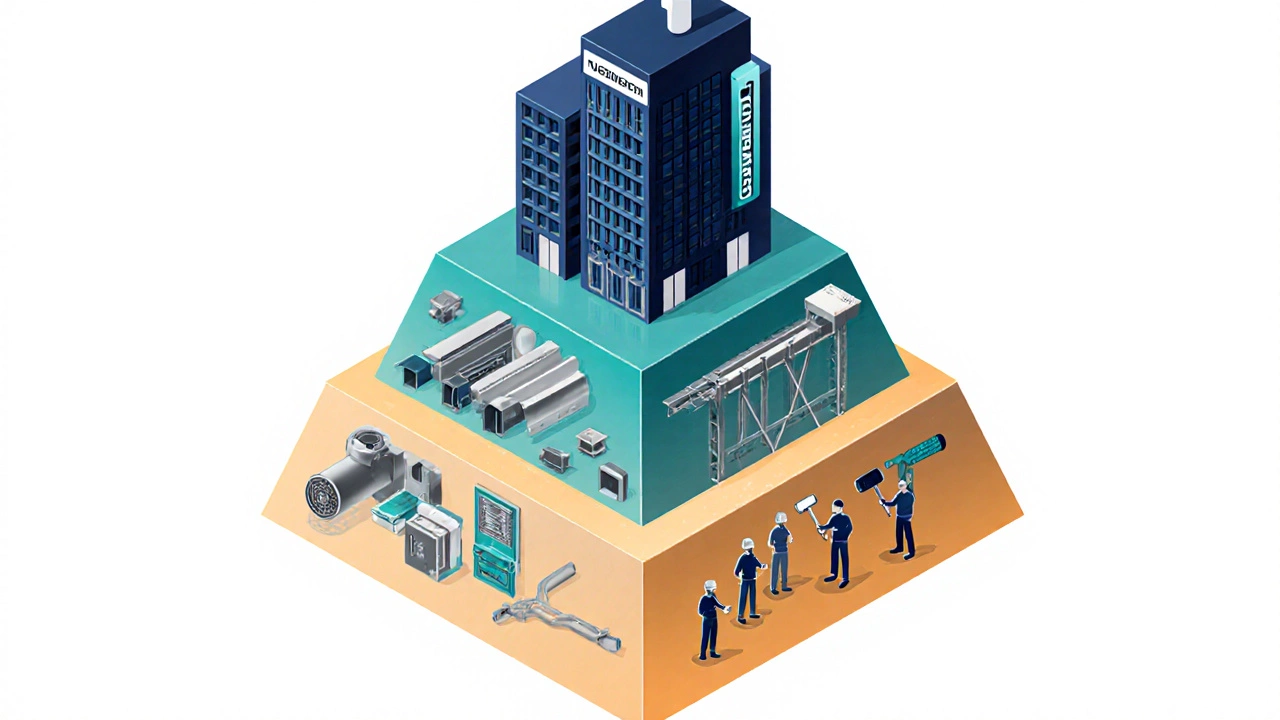Contractor Tier Selection Tool
Select Your Project Parameters
Answer these questions to determine which contractor tier is most appropriate for your construction project.
Recommended Tier
Best for large, complex projects
Full project management
Best for medium-sized projects
Specialty trade management
Best for small, simple projects
Labor-intensive work
If you’ve ever opened a bid package and seen the terms Tier 1, Tier 2, or Tier 3, you probably wondered what the real difference is. Those labels dictate who does what on a job, how risk is shared, and how much you’ll pay. This guide breaks down each tier, shows where they sit in the overall project hierarchy, and gives you practical tips for picking the right level for your next build.
What is a Tier 1 contractor is a prime or “head” contractor who takes a single contract directly from the owner and manages the entire construction process.
A Tier 1 contractor is the face of the project for the client. They are responsible for overall scheduling, budgeting, quality control, safety, and legal compliance. Because they hold the primary contract, they also carry the greatest financial and performance risk. In large‑scale commercial builds, Tier 1 firms are often nationally recognized companies with deep balance sheets and a roster of specialty subcontractors.
What is a Tier 2 contractor is a mid‑level subcontractor hired by the Tier 1 prime to perform a specific trade or discipline.
Tier 2 contractors specialize in systems such as HVAC, electrical, or structural steel. They work under the direction of the Tier 1 prime but have more autonomy than a Tier 3 crew. Their contracts are usually larger (often $500 k-$5 M) and they may also subcontract portions of their scope to Tier 3 firms.
What is a Tier 3 contractor is a small‑scale subcontractor that provides labour‑intensive, low‑margin work like drywall, painting, or concrete finishing.
Tier 3 firms are the “hands‑on” crews that turn plans into reality at the building‑site level. Their contracts are typically under $500 k and they are hired by Tier 2 subcontractors or directly by a Tier 1 prime on very focused tasks. Because they sit at the bottom of the risk chain, Tier 3 contractors normally have the least profit cushion.
How the tiers fit into the overall hierarchy
Think of the construction chain as a pyramid. At the top sits the General Contractor the entity that oversees the entire construction effort on behalf of the owner. In many projects the General Contractor is also the Tier 1 prime, but they can be separate when the owner hires a design‑build firm.
Below the General Contractor are the Tier 2 specialists. They each manage a segment of the work and may, in turn, bring in Tier 3 crews to finish the details. The flow of information, payments, and risk moves downward: the owner pays the Tier 1 prime, who pays Tier 2 subcontractors, who pay Tier 3 crews.

Comparison table: Tier 1 vs Tier 2 vs Tier 3
| Tier | Typical Project Size | Scope of Work | Risk Level | Typical Payment Terms |
|---|---|---|---|---|
| Tier 1 | $10 M-$500 M+ | Full‑build management, permits, coordination | High - primary liability to owner | Retainage 5-10% until punch‑list |
| Tier 2 | $500 k-$10 M | Specialty trades (HVAC, structural steel, etc.) | Medium - performance tied to Tier 1 schedule | Milestone payments, 5% retainage |
| Tier 3 | Under $500 k | Labor‑intensive trades (drywall, painting) | Low - subcontracted risk | Weekly/bi‑weekly invoices, little retainage |
When to hire each tier
- Tier 1: When the project is large, complex, or public‑sector where a single point of responsibility is required.
- Tier 2: Ideal for mid‑size commercial or multifamily projects where the owner wants expert trade management without the full overhead of a prime.
- Tier 3: Best for small‑scale renovations, tenant‑improvements, or any job where a single trade can be managed directly by the owner or by a Tier 2 lead.
Pros and cons of each tier
Tier 1
- + Centralized communication reduces owner workload.
- + Strong financial backing helps keep cash flow steady.
- - Higher fees (often 10‑15% of total contract).
- - Slower decision‑making when many layers of management are involved.
Tier 2
- + Specialized expertise leads to higher quality trade work.
- + More flexible scheduling than a large prime.
- - Must coordinate with both Tier 1 and Tier 3, which can cause clashes.
- - Limited ability to absorb major cost overruns.
Tier 3
- + Lowest cost per square foot, ideal for tight budgets.
- + Fast turnaround, as crews are small and focused.
- - Little leverage on change orders, so owners must be clear up front.
- - Higher turnover risk if Tier 2 fails to pay on time.
Common pitfalls and how to avoid them
- Assuming all tiers are interchangeable. Each tier brings a distinct risk profile. Match the tier to the project size and complexity.
- Skipping due‑diligence on Tier 2 or Tier 3 financial health. Request at least two years of audited financial statements.
- Over‑relying on retainage for cash flow. Negotiate milestone payments that align with actual work progress.
- Neglecting clear scope definitions. Use a detailed Scope of Work (SOW) attached to every subcontract.
- Ignoring insurance and bonding requirements. Tier 1 must hold a performance bond; Tier 2 and Tier 3 should carry workers’ comp and general liability.

Checklist for selecting the right tier
- Project budget: >$10 M - Tier 1; $500 k-$10 M - Tier 2; <$500 k - Tier 3.
- Owner’s tolerance for risk: high risk → Tier 1; moderate → Tier 2; low → Tier 3.
- Complexity of design and permitting: complex → Tier 1 prime.
- Desired level of communication: single point of contact → Tier 1.
- Availability of local specialty subcontractors: if strong, you can lean on Tier 2.
Real‑world example
A midsize office building in Austin, Texas, with a $12 M budget hired a Tier 1 general contractor. That prime brought in a Tier 2 mechanical contractor for the HVAC system and a Tier 2 structural steel firm. The steel firm, in turn, hired a Tier 3 crew for bolting and welding. Because each tier was clearly defined, the project finished on schedule, the owner only faced one payment schedule, and the retainage held by the owner was released after final punch‑list verification.
Key takeaways
- Tier 1 handles overall responsibility and biggest risks.
- Tier 2 provides specialized trade expertise.
- Tier 3 delivers labor‑intensive work at the lowest cost.
- Match tier choice to project size, risk tolerance, and desired control level.
Frequently Asked Questions
Do Tier 1 contractors also act as subcontractors?
Usually not. A Tier 1 contractor holds the prime contract with the owner and manages the whole project. When they perform specific trades themselves, they’re acting as a subcontractor under their own prime contract, but most owners separate the prime and trade work to keep responsibilities clear.
Can a Tier 2 contractor hire multiple Tier 3 crews?
Yes. Tier 2 firms often act as mini‑primes for their specialty. They will subcontract portions of their scope-like drywall or painting-to several Tier 3 subcontractors to keep the schedule moving.
What insurance should each tier carry?
Tier 1 primes need a performance bond, general liability of at least $5 M, and workers’ comp. Tier 2 specialists should have similar coverage but can often get away with lower limits if the prime assumes some risk. Tier 3 crews must have workers’ comp and $1-2 M general liability, as their exposure is limited to the tasks they perform.
How does retainage affect cash flow for Tier 3 firms?
Since Tier 3 contracts are smaller, a large retainage percentage can seriously strain their cash flow. Negotiating a lower retainage (2-5%) or a phased release tied to completed milestones helps them stay solvent while still protecting the owner.
Is it ever okay to bypass a Tier 1 contractor for a large project?
In some design‑build or construction‑management‑at‑risk models, the owner works directly with multiple Tier 2 and Tier 3 firms under a single management umbrella. It can work, but the owner must be comfortable handling the added coordination and risk tracking themselves.







